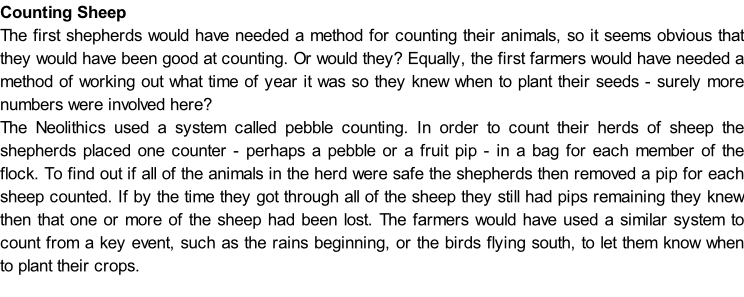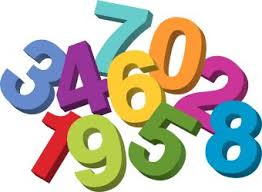













Counting in Tens
Like children today, we can be fairly sure that our early ancestors used their fingers for counting — a key development along the way to numeracy. Humans have eight fingers and two thumbs, and if you watch my young child learning to count or add (counting is in fact just adding on one each time), you'll see that these convenient ten counters are too tempting not to use. Consequently we instinctively like the idea of numbers coming to us in batches of ten.
We can also use our fingers to communicate numbers non-
The upper limit for counting on your fingers is ten, which would have been more than enough for many Stone Age people. As societies developed, larger numbers were required, yet counting in batches of ten continued. The modern-
On Cloud Nine
In case you haven't been fortunate enough to go there, Cloud Nine is a metaphorical place of great joy or euphoria. The origin of this expression is often attributed to a system of cloud numbering created in the 1950s by the US Weather Bureau. However, while it is eminently possible that meteorology was behind Cloud Nine, to attribute the system to the US Weather Bureau is incorrect, as the original classification actually came in the International Cloud Atlas of 1896. The Atlas classification gave the cumulonimbus cloud the number nine out of a list of ten. This cloud is one of the highest (reaching heights of 45,000 feet) and is certainly the fluffiest and most comfortable-
Unlucky Thirteen
If you are worried about the number 13 being unlucky, then it can make life very difficult. in fact, you'd probably be best off living in the lift of a hotel if at all possible, since they very often don't have a button for the 13th floor, jumping instead from 12 to 14. (Whether there actually is a secret 13th floor that can only be reached by the stairs is something no one seems inclined to ask.) There is also the hassle of explaining your problem to others, as the fear of number 13 is technically known as 'triskaidekaphobia', which is quite a mouthful. Such concerns mean you may have to make numerous adjustments in daily life. For example, some people believe that to have 13 people around a dinner table is unlucky, and tradition dictates that a teddy bear or the like be given a seat to increase the numbers. Superstition suggests that refusing teddy his chair means that one of the guests will die — which leads us to the first of many explanations for 13 having such a bad reputation.
There are two dinner invitations that have gone down in history as being to blame for 'unlucky number 13'. The first is the Last Supper, where the Bible tells us that Jesus and his 12 disciples (making a total of 13, obviously) met for the last time to eat before he was betrayed and then crucified. The other infamous supper date is from Norse mythology, where the most mischievous of the gods, Loki, arrived uninvited to dinner, becoming the 13th guest. During the course of the evening, he tricked one god into killing another. The latter happened to be associated with beauty, joy and righteousness, making the freeloading Loki very unpopular indeed.
Perhaps the most likely reason for 13 having a bad name, however, is quite simply because it is the poor neighbour of number 12. From ancient cultures to the modern day, 12 has been seen as a number of completion. There are 12 hours on the clock face, 12 months in a year and 12 signs of the zodiac. This being the case, 13 ventures into the unknown and messes about with the space—time continuum.
The Secret of the Missing Penny
You might think you're a savvy shopper and you'd see past age-
This phenomenon is evident all over the world and for all our modern retail nous it still seems to work. As recently as 2008, academics in France studied what happened when a pizza was sold for €8.00 and €7.99. It turned out that knocking off that one cent increased sales by 15 per cent. These results are all the more incredible in a world where inflation has made the extra penny you get back pretty useless – surely everyone has a pile of these horrible little coins lurking around their house somewhere, don't they?
The Baker’s Dozen
Those of us lucky enough to be given 13 loaves of bread when we've only requested (and paid for) 12 are the beneficiaries of an age-
The thirteenth-
•
The Assize law remained on the books for hundreds of years, only being repealed by the Statute Law Revision Act of 1863.
As the precise amount of food you got in the Middle Ages could be a matter of life and death, the penalties for ripping customers off could be brutal. Since bread was a staple for many societies, bakers were targeted with particular ferocity. Those who 'short-
Historians note that originally the practice would have applied to any number of loaves sold, not just 12, because the law was based on total weight rather than total number.
Why 44?
UK residents who happen to dial North America while also having a loose grasp of history might be struck by the thought that there is something amiss. 'How come the US got +1 as its international dialling code, while the UK only got measly old +44?' they might ask. 'Didn't one of our lot invent the phone in the first place?' There is a certain sympathy to be had with that view. Indeed a Brit, or a Scot to be precise, Alexander Graham Bell, is widely credited with inventing the telephone in 1876.
But the fact is history, or nationalism for that matter, doesn't have much bearing on the international telephonic pecking order.
It was the CCITT – or Comite Consultatif International Telephonique et Te1e'graphique if you'd rather – that was behind the digits you dial for a foreign chat. This body is now known as the International Telecommunication Union, an agency of the United Nations that is charged with setting international standards for telecommunications. The CCITT created the precursor of the modern system of international telephone country codes with its Red Book (nothing to do with Chairman Mao). This 1960 tome featured a list of country codes for Europe. It was probably never used by customers trying to make calls, as most were still connecting with each other through operators.
As a European directory (despite somewhat cryptically including several Middle Eastern countries and Russia), North America didn't even get a look-
The system was given an overhaul in 1964, with most countries already assigned numbers losing them. Only a few countries got to keep their original codes, including Greece (+30), Italy (+39), Sweden (+46) and the UK (+44).
The Red Book was superseded by the Blue Book, which divided the world into nine areas and, you guessed it, North America got area number one. The full list of World Zones goes like this:
1 – North America 2 – Africa 3 and 4 – Europe (it got two because there were so many countries)
5 – South America 6 – South-
8 – East Asia and others, including the Inmarsat satellite network 9 – Western Asia and the Middle East
Each country's code was thus determined by which zone it was in. So, for example, all African codes start with a 2, such as +27 for South Africa.
The African code also includes the newest member of the international dialling community, South Sudan, which was granted +211 in 2011 when it gained independence. The first, historic, call on the number was made by the Undersecretary in the Ministry of Telecommunications to his daughter in Australia. Fortunately, it didn't go to answer phone.
Looking at the original Blue Book is also a reminder of just how the world has changed in 50 years, listing, as it does, North and South Rhodesia, West Germany and Czechoslovakia, amongst other names that echo down from history.
